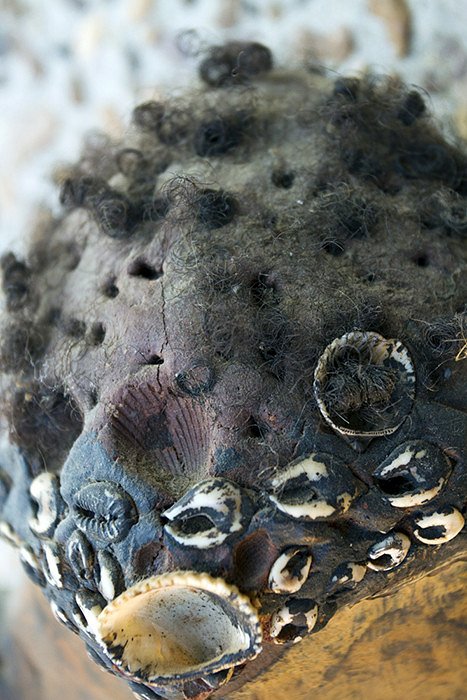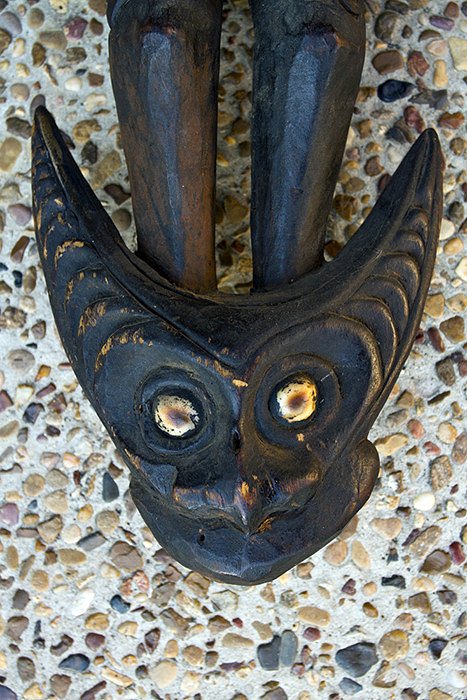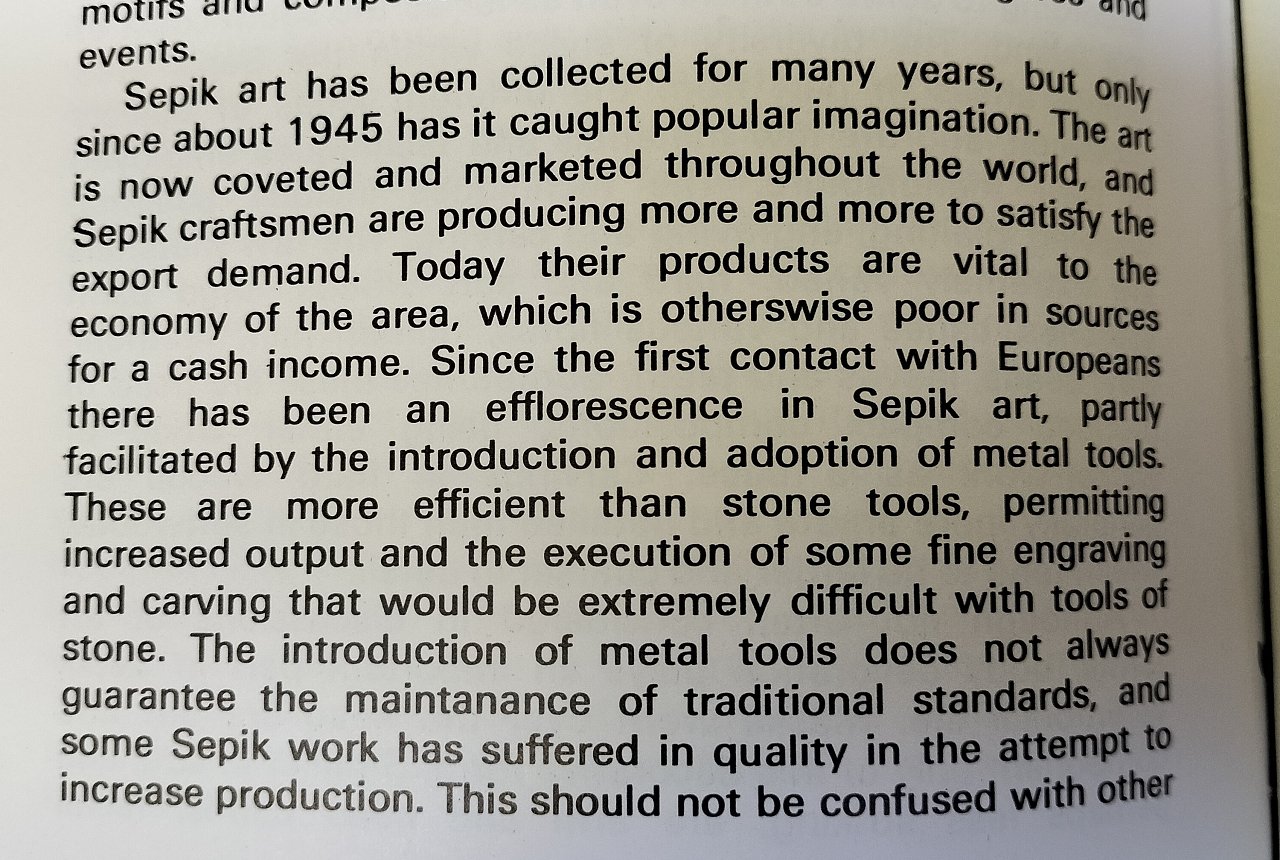Tiki Central / Collecting Tiki
Share your Papua New Guinea pieces
|
PP

Prikli Pear
Posted
posted
on
Thu, Oct 10, 2024 1:11 PM
Up until now I didn't have much in the way of PNG art, but my wife scored at an estate sale in Canyon Lake this past weekend. She came away with three impressive pieces. These are tourist pieces (as confirmed by an appraiser), but I think they're great and serve my needs nicely. First up is a spirit mask originating from Mindabit (Mindimbit) Village at the junction of the Sepik and Karawari Rivers in Papua New Guinea. This is the only piece that came with any type of documentation and describes the mask as having "legendary bird on forehead." There are holes along the length of the bird that look like some kind of decoration (raffia?) was tied there in the past. It is my understanding these date from sometime after 1960. The house they came from was small and built in the 1970s. I'm guessing this mask (as well as the other pieces) is nearly 50 years old.
|
|
PP

Prikli Pear
Posted
posted
on
Thu, Oct 10, 2024 1:16 PM
This next mask is more along the lines of what I consider a prototypical PNG mask. It's bright and bold and that's why I immediately thought it was most likely a tourist piece. It's too fresh and clean, if you take my meaning, although it's likely close to 50 years old. It's quite showy and will make a great attention-getter in my tiki space. I had no documentation with it, so my best guess is Middle Sepik as area of origin.
[ Edited by Prikli Pear on 2024-10-10 13:36:28 ] |
|
PP

Prikli Pear
Posted
posted
on
Thu, Oct 10, 2024 2:11 PM
The last piece I have to share is a suspension hook. I have no idea of the provenance, but dang, this is an amazing piece. It measures roughly 30" and the amount of detail is well above what I normally see in tourist pieces. The head has actual human hair embedded and the jawline has a line of indentations that once held feathers. There's a patina of age and enough missing shells that I feel this one is significantly older than the masks, although I can't prove it. Certainly, it's now the centerpiece of my modest collection.
[ Edited by Prikli Pear on 2024-10-10 14:12:30 ] |
|
S

swizzle
Posted
posted
on
Sat, Oct 12, 2024 2:17 AM
in reply to Prikli Pear
You mention that all three of the pieces you posted are 'tourist' pieces with the first one being confirmed by an appraiser. Unless you have acquired the piece from a museum, a great grandparent who was an adventurer and collected them personally 100yrs ago, or a private collector who acquired them the same way, then just about EVERYTHING that Tikiphiles decorate their homes with are tourist pieces. This is a book i have that was printed in 1972.
And here are a couple of excerpts from it in the introduction.
Note the mention of the year 1945. That was the year that commercial air travel really took off, so people were traveling to places like PNG and able to bring items back themselves in their luggage. Or if you were well off you could afford to have larger pieces shipped home. The tribes of PNG were making items for trade long before that when Westerners first discovered them and took interest in their art and artifacts and they found that they could trade them and were happy to do so because if something really didn't hold any significant spiritual meaning then they could just make another one. After 1945 when there was a significant influx of visitors that's when they really ramped up production specifically for the 'tourist trade' and started making more smaller pieces that could fit in suitcases, like masks as mentioned in the book above, so the ages you give for each piece are most likely quite accurate. I agree that the last piece (which is very cool by the way) does look significantly older than the others, but by how much, who knows. Without having 100% confirmed proof of when any of this stuff was collected then we can only guess at how old they are. [ Edited by swizzle on 2024-10-12 02:20:34 ] |
|
PP

Prikli Pear
Posted
posted
on
Sat, Oct 12, 2024 10:53 AM
in reply to swizzle
Swizz, yeah, I'm aware of that. The thing that surprised me in trying to find out more about these is the utter dismissal and contempt shown toward so-called "tourist pieces" by people in PNG collector groups. "Worthless," "no value" and "tourist garbage" are phrases I've seen repeated. That's dramatically different responses from what I've seen in tiki circles--and I know tiki folk can be snobs in their own way. The attitude is striking, because I know in the Pacific Northwest Native American artists are creating modern versions of traditional carvings and regalia specifically for the art market and these pieces command high values. Contrast that with PNG art, where villagers create masks and carvings using traditional materials and techniques, yet collectors deem these as worthless if they weren't actually used in yam ceremonies, etc. It's stunning. I have no interest in selling any of my pieces regardless of their intrinsic value. For many PNG experts, resale value is the only thing that matters. Oh, and I need to get that book! Off to check ABE... |
|
S

swizzle
Posted
posted
on
Sat, Oct 12, 2024 10:25 PM
in reply to Prikli Pear
If you're talking about the Oceanic art groups on Facebook Prikli Pear then i totally agree with you. 90% of the comments are exactly what you said, and of the 10% that are helpful and say where the item is from, half of those will still say it's a worthless tourist item. It really pisses me off actually. Not everyone can afford, or has access to, museum quality and/or vintage collections, and most people don't care. Sure most people, myself included, would love to say, "Oh that piece was collected in 1924 from a village in PNG" and not, "I got it at a market stall in PNG outside the airport", but we collect these artworks because they're amazing hand crafted items that look cool. Not because of their monetary value. And i definitely recommend tracking down that book i posted. Has a lot of photos of masks (and other artwork) in it. This book was printed in 1974.....
And this one i actually won at a local auction house just last week.
|
|
PP

Prikli Pear
Posted
posted
on
Mon, Oct 14, 2024 8:15 AM
Thanks for the additional book recommendations! Most of the references I currently have on Sepik River art are wrapped up in "Oceanic Art" collections which include various Polynesian and Australian art as well. And you're right about the FB groups--there's a lot of knowledge there, but they are harsh. |



















 .....and although it does have quite a few pics of artwork in it, it is more about the people. Still worth grabbing if you can find it for a reasonable price.
.....and although it does have quite a few pics of artwork in it, it is more about the people. Still worth grabbing if you can find it for a reasonable price. Printed in 1988 but still full of older works and more like a catalogue like the first book i posted. I highly recommend this one as well.
Printed in 1988 but still full of older works and more like a catalogue like the first book i posted. I highly recommend this one as well.